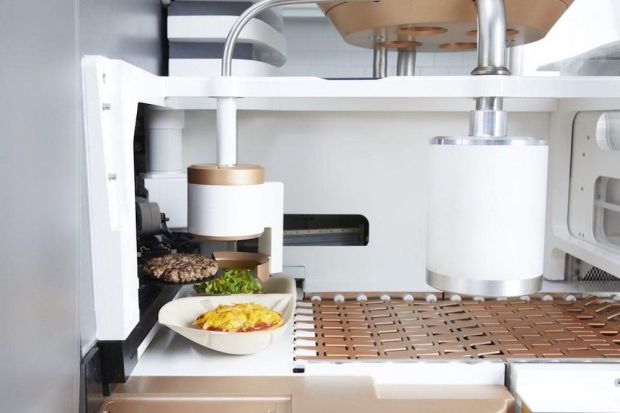Creator’s Robo-Burger: The Natural Evolution Of Fast Food?

When most people talk about the future of automation in fast food and QSR, they are mostly thinking about the front of the house – the kiosks popping up in places like McDonald’s and Shake Shack that do the heavy lifting of ordering, but send those automated orders to the back of the house, where human hands still make the burger.
But the team at Creator, the mysterious startup that has been building the eponymous burger-making machine since 2012, is looking to reverse the direction. The cooking, in their opinion, can and even should be taken on by a machine, as they believe that brings many enhancements to the entire experience.
One of those enhancements, however, is keeping the front of the house a more personal contact-centered space. They don’t have kiosks, and they don’t want kiosks.
“The idea of not talking to someone seems straight up dystopian to me. We’re at the point that we firmly believe you cannot automate human creativity and social interaction. Our utopian future is one where there is more creativity and more social interaction, while staff members also get to be more creative and social,” CEO Alexandros Vardakostas told Fortune shortly before the restaurant opened on the ground floor of an office building on San Francisco’s Folsom Street.
The web has been quietly buzzing about Creator’s “burgermatic” machine for the last six years, fueled by the rather pronounced secrecy of the firm. Vardakostas says that his preference has always been to show the world what the machine can do, rather than just telling people about it.
And by most accounts, what the machine can do is impressive. Measuring in at 14 feet, the burger bot comes equipped with 350 sensors and 20 microcomputers programmed to a single mission: to produce the best burger you can buy in America for $6.
That’s about $1.30 more than what a Big Mac runs in San Francisco these days.
And the Creator burger is, for lack of a better term, fancier than its Golden Arches-produced counterpart. The meat and produce is locally sourced and fresh, and the toppings list strays toward the artisanal, with options like umeboshi plums and smoked oyster aioli. That level of ingredient quality is, in some sense, paid for by the machine itself. The shop obviously needs fewer workers – but, more critically in an expensive-by-square-foot city like San Francisco, it needs a much, much smaller kitchen space. And Creator is pretty obsessed with those ingredients, with plans to allocate more than 40 percent of its revenue to their cost.
But more than an advanced ingredient list, the burgers themselves are highly customizable. The Creator machine wasn’t built make one kind of burger, but is programmable to offer up a series of different combinations of flavors, ingredients and condiments to the customers’ liking.
“We wanted to design a device that meets nature where it is, and not make food conform to a robot,” Vardakostas told The Verge in an interview. “We didn’t want something that would make one kind of burger. We look at this like a platform for recipes, and we wanted as much culinary creativity as possible.”
And, according to Vardakostas, the use of a machine itself aids in that – because the Creator wasn’t designed to do human tasks in a robotic way, but instead leverages the fact of its automation to do some things better. That means no two burgers cook for the same amount of time, but everything comes off the grill at the correct temperature and the meat is ground differently (and in a way that’s almost impossible to do correctly by hand). The machine can also slice ingredients by the millimeter, and can customize low-sodium orders by salting the bottom of the bun so it can still be tasted.
And the machine can, and will, learn new tricks as the company gets a better feel for the burger business.
The time is now for this, according to Vardakostas, because artisanal ingredients can and should be affordable to all – if enough creativity is employed in bringing them to the table.
“Food and commodities prices have been decreasing decade over decade. Interestingly, though, food prices seemed to have tailed off around 2000,” noted Vardakostas. “Farmers and tractors did amazing things for society in general, and this feels like the next advancement to bring dramatic reductions to the cost of food while increasing its quality and consistency.”
The next step forward is happening at a measured pace. These days, one can only eat at Creator by reservation on Wednesday and Thursday throughout the month of July, while the firm is doing the last of its debugging and making sure everything runs up to snuff.
But the goal – coming someday soon? – is for customers to be able to order takeout using the company’s mobile app, or to be served by staff armed with iPhones waiting to take their orders in the store.
The future of the burger, it seems, is here – and if the rave reviews are to be believed, it may just be robotic.
